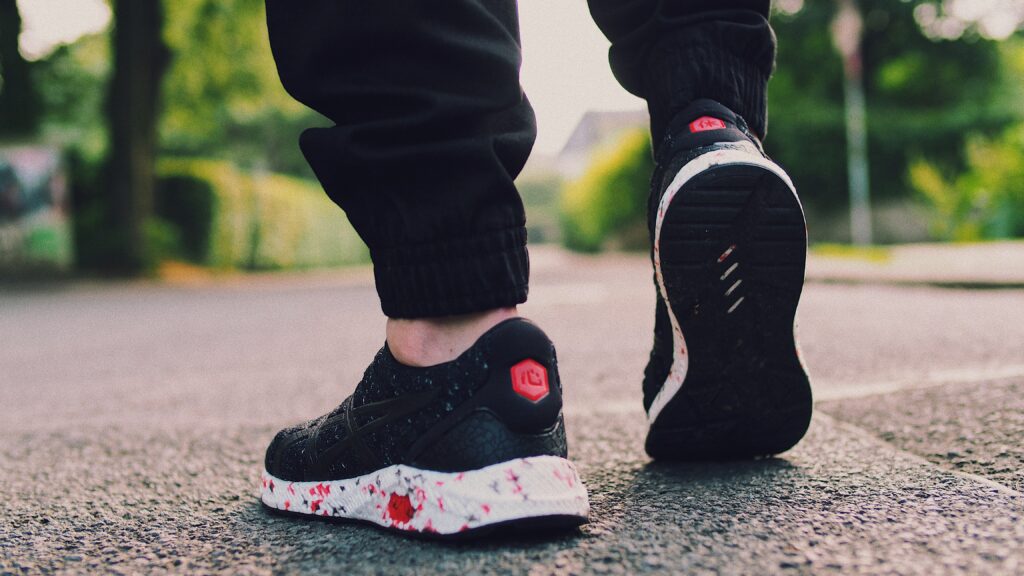Foot Complication for Diabetics
If you have diabetes, then you are probably already aware that this condition can cause complications and, most notably, diabetic foot problems.
While anyone can experience foot conditions such as Athlete’s foot, fungal nail infections, and calluses, if you have diabetes, these can lead to infections and serious complications such as amputation.
Fortunately, with the right treatments and preventative measures, you can avoid diabetic foot problems and keep your feet in optimal condition.
Read on to find out:
- What is diabetic foot?
- How does diabetes affect the feet?
- What are the most common signs of diabetic foot?
- What are the most common diabetic foot conditions?
- What are the complications of diabetic foot?
- How to treat diabetic foot problems?
- How to care for and prevent diabetic foot at home
- Diabetic foot FAQs
What is diabetic foot?
Diabetic foot is a broad term used to describe foot problems that are more common in people with diabetes. Typically, diabetic foot problems occur over time due to high blood sugar levels, which damage the nerves and blood vessels in the feet.
Although diabetic foot problems can be highly dangerous if left untreated, most can be managed and treated with either over-the-counter remedies or prescribed medications.
There are also several preventative measures that you can take to reduce your risk of developing diabetic foot conditions.
How does diabetes affect the feet?
If you have diabetes, you are much more at risk of developing foot problems such as foot ulcers, infections, and, in the worst case scenario, amputations.
There are many different ways that diabetes affects the feet, including:
- Raised glucose levels can damage the sensation in your feet
- High blood sugar can affect your circulation and result in less blood flow to the feet
- Poor circulation can make it harder for cuts and sores to heal
- Increased likelihood of cramps and pain in the feet and legs
What are the most common signs of diabetic foot?
If you are diabetic and you notice any of the below signs of diabetic foot, then you should make an appointment with your doctor or podiatrist:
- Changes in skin colour such as diabetes black foot
- Changes in skin temperature
- Swelling of the feet, ankles or legs
- Pain in the legs
- Open sores on the feet that are not healing
- Toenails that are infected with fungus
- Hard and thick patches or lumps on the feet
- Dry cracks in the skin
- A bad odour

What are the most common diabetic foot conditions?
As mentioned briefly above, anyone can experience a foot problem such as Athlete’s foot or a fungal nail infection. However, the difference is, if you are diabetic, you are much more at risk of developing serious complications if these conditions are left untreated.
The most commonly diagnosed diabetic foot conditions are:
Athlete’s foot
Athlete’s foot is a type of fungus that most commonly affects the skin in between your toes. Causing itching, redness and sometimes cracking, Athlete’s foot can be easily treated using over-the-counter anti-fungal medication.
Fungal nail infection
If your toenails become infected by a fungus, they are likely to turn yellow, thicken or become brittle. You may also notice a bad odour, sometimes referred to as diabetes stinky feet.
In people with diabetes, fungal nail infections can be hard to treat so you should visit your doctor for a bespoke treatment plan.
Calluses and corns
Calluses and corns can affect the feet and hands and manifest themselves as hard, thick skin. A diabetic callus can be caused by ill-fitting footwear or by an uneven distribution of weight. A diabetic corn on foot often occurs when your shoes rub against your feet and cause friction.
There are several home remedies for corns and calluses, but you should never try to cut these off yourself.
Blisters
Blisters most commonly occur when your shoes repetitively rub against the same spot on your feet. You should not pop blisters if you are diabetic as this can lead to an infection.
Bunions
Bunions occur when your big toe bends into your second toe. Bunions can be very painful and can form on one or both of your feet.
Although bunions can run in a family, most are caused by wearing high-heeled shoes that put pressure on your big toe.
Diabetic ulcers
One of the more serious diabetic foot problems, foot ulcers can easily become infected if left untreated. A foot ulcer can occur from a minor scrape or cut and then develop into a deep sore or break in the skin.
It is estimated that up to 10% of people with diabetes suffer from foot ulcers.
Ingrown toenails
Ingrown toenails happen when the edges of the toenails start to grow into the skin. This can cause pressure and pain in the nail and foot.
Ingrown toenails are often caused by ill-fitting footwear, but they can also occur if you do not trim your toenails regularly. In diabetics, ingrown toenails are more at risk of becoming infected.
Charcot foot
Charcot foot is a serious foot complication that can result in foot ulcers, and even amputation. This diabetic foot condition occurs when you lose the sense of feeling in your feet and cannot notice injuries such as broken bones because of this.
Due to a lack of sensation, you can continue to walk on your affected foot without feeling any pain. This can cause the bones in your foot to change shape and become deformed.
Dry skin on feet
Diabetes and dry skin on feet often go hand in hand, so it is important that you take steps to keep your feet hydrated and moisturised. If left untreated, dry skin can crack, which allows germs and bacteria to enter. This can lead to an infection.
Plantar warts
Plantar warts are often confused with calluses as they are similar in appearance. Typically found on the ball of the foot or on the heel, plantar warts are painful and can grow individually or in clusters.
What are the complications of diabetic foot problems?
If diabetic foot problems are left untreated for too long, you might be at risk of several severe complications, including:
Infections
Skin and bone infections are common in people with diabetes, and even a small cut or crack in the foot can lead to an infection. Foot sores and diabetes are also common and can lead to an infection.
Abscesses
If an infection is left untreated, this can eat into the bone or skin tissues of the foot and cause an abscess. Abscesses can be very painful and require urgent treatment.
Gangrene
Diabetes can limit the blood flow to your fingers and toes. If this blood flow becomes cut off, gangrene can occur. This is an extremely dangerous complication and can result in the need for amputation if left untreated.
Deformities
Foot deformities such as hammertoes and claw feet can occur when diabetes is not properly managed. This occurs due to nerve damage that weakens the muscles in your feet.
Amputation
In rare cases, issues with blood flow can result in the need for amputation. This can become necessary if an infection is left untreated and creates an abscess or low blood flow causes gangrene.
How to treat diabetic foot problems?
Depending on the specific diabetic foot problem that you have, there are several diabetic foot care treatment options available.
Antibiotics
If you have developed an infection due to a diabetic foot problem, then your doctor will prescribe a course of antibiotics to treat the infection and prevent further complications.
Anti-fungal medications
If you have developed Athlete’s foot, then you can treat this diabetic foot condition with an over-the-counter antifungal medication. These do not require a prescription and are usually applied topically to the affected area in the form of a cream.
Medicated foot creams
If you suffer from dry skin on your feet or hard skin due to a corn or callus, then a foot cream is your best choice for diabetic callus treatment. One of the most effective foot creams on the market is CCS Foot Care Cream which is specially formulated to treat dry skin on the feet.
Foot creams are also a good choice if you have cracks in feet diabetes, or you suffer from diabetes and smelly feet.
Surgery
Severe diabetic foot problems such as Charcot foot and other deformities may require surgery. This will be dependent on the level of damage to your foot. In some cases, amputation may be needed.
How to care for and prevent diabetic foot
To prevent diabetic foot problems, follow the below diabetic footcare practices and diabetic foot care at home techniques:
Take care of your overall health
As a diabetic, you need to be vigilant of your overall health as you are more prone to certain conditions. Make sure that you follow your doctor’s advice on nutrition, exercise and medication and keep your blood sugar levels within the healthy range.
Wash your feet daily
Make sure that you wash your feet everyday in warm water and that you use a gentle soap or diabetic foot wash. Always check the temperature of the water using your elbow as diabetes can affect the sensation in your feet and hands.
If you suffer from diabetes and smelly feet, you may want to wash your feet more than once per day.
Check your feet daily
Once you have washed your feet, you should then check them over. Look for sores, blisters, redness, calluses, corns and anything else that looks problematic.
If you suffer from bad circulation, it is even more vital to check your feet each day as you are more prone to complications.
Apply a foot cream or lotion
Apply a foot cream after washing to keep the skin on your feet in optimum condition. Look for a foot cream that contains hydrating and restorative ingredients like urea and salicylic acid, such as CCS Foot Care Cream.
Avoid putting foot lotion between your toes as this can make diabetic foot conditions worse.
Use a pumice stone or foot file
If you have noticed patches of dry, thick or hard skin developing on your feet, use a pumice stone or foot file to gently file these away. Pumice stones and foot files should be used after showering or bathing as this is when the skin on your feet is at its softest.
Aim to remove the top layer of skin only, as otherwise, you risk making the skin bleed which can cause an infection.
Trim your toenails regularly
You should trim your toenails once a week to avoid diabetic foot complaints such as ingrown toenails. Always cut straight across the nail and then trim the sides. Smooth away any rough edges with a nail file.
Avoid walking barefoot or in open-toed shoes
Walking barefoot, in open-toed shoes, or ill-fitting footwear can make you more susceptible to common diabetic foot problems such as corns and calluses, Athlete’s foot and dry skin.
Therefore, you should make sure that wear well-fitting footwear that offers the support your feet need.

Keep the blood flowing to your feet
Circulation issues are common in diabetics, so you need to ensure that you are keeping the blood flowing to your feet. You can do this by keeping your feet elevated when sitting down, wiggling your toes and rotating your ankles several times a day, and avoiding crossing your legs for long periods.
Stop smoking
Smoking is bad for your circulation and for your skin. It can also make you more prone to diabetic feet problems. If you are struggling to give up smoking, talk to your doctor about the different treatment options available to you.
Go for regular check-ups
One of the most important things you need to do for diabetic foot health is schedule regular check-ups with your doctor. Although you may be able to spot some issues yourself, your doctor should carry out a thorough examination of your feet at least once a year.
Frequently asked questions
How does diabetes affect the feet?
Diabetes affects the blood flow to the feet, making you more susceptible to foot problems such as fungal infections, foot ulcers, blisters, and bunions. If you do develop a foot condition and it is left untreated, you are also more prone to infections, abscesses, and gangrene.
Is itchy feet a sign of diabetes?
Yes, itchy feet can be a sign of diabetes. Uncontrolled high blood sugar can cause damage to the nerves in your legs and feet, known as diabetic peripheral neuropathy. This can result in itchy feet, tingling in the feet, and an inability to feel pain.
What are the signs of diabetic feet?
The most common signs of diabetic feet are a change in skin colour, a change in skin temperature, pain in the feet or legs, swelling in the foot or ankle, numbness, tingling or burning sensations, and muscle weakness.
What do diabetic feet look like?
Diabetic feet are not always noticeable, but you may notice a change in skin colour, a change in the appearance of your toenails, open sores on the feet, dry patches or cracks in the skin, and swelling of the feet and ankles. Even if you do not notice any apparent symptoms of diabetic feet, you should still have your feet checked over by your doctor at least once a year.
What does diabetic foot pain feel like?
Diabetic foot pain tends to be a sharp shooting pain rather than a dull ache, although this will be dependent on what type of foot condition you have. If you have nerve damage as a result of your diabetes, then you may lose all feeling in your feet.
What is diabetic foot?
Diabetic foot is a broad term used to describe foot problems in people with diabetes. Some of the most common diabetic foot conditions are Athlete’s foot, corns, calluses, blisters, and dry skin.
Why does diabetes affect feet?
Diabetes can cause your blood glucose levels to rise, which can cause a loss of sensation in your feet. This can make you more susceptible to serious complications such as foot infections and abscesses. However, if you manage your diabetes and check your feet regularly, you can avoid most of these issues.
Does diabetes affect your feet?
Yes, diabetes affects the blood flow to the feet, increasing your risk of foot problems such as foot ulcers, infections, and more serious issues such as abscesses and foot deformities.











